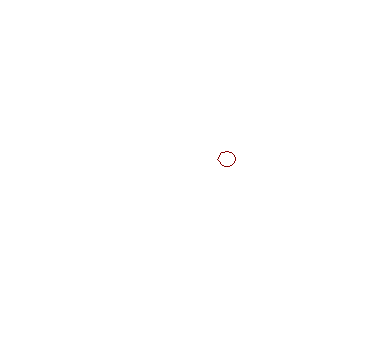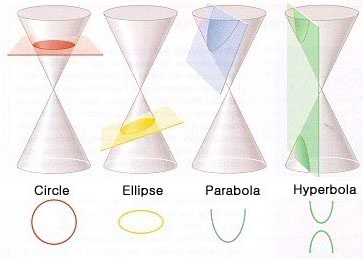|
1.
Introduction
This
animation conveys the essence of this unit: the circle, ellipse,
parabola and hyperbola all belong to the same family of curves,
called the conics.
Studying
the conics provides us with a context to further develop our understanding of the Analytical
Geometry method, integrating Geometry and Algebra, and to re-visit our understanding of the content of the parabola and the hyperbola by seeing them in a new
light.
We briefly outline
three different ways of looking at the conics.
|

|
Conics
as cuts from a cone
The ancient Greeks
have already studied the Geometry of how cutting a double cone at different
angles produces either a circle, an ellipse, a parabola or an hyperbola.
It is also possible to get other shapes as special
cases, e.g. can you cut the cones to get a point or a straight
line?
The word “conic”
is derived from the word “cone”.
The origin of our words "hyperbola", "ellipse" and
"parabola" also come from the Greek study of the conics:
|
|

|
- Parabola, meaning
“besides”, when the cut is made parallel to the
side of the cone, or at an angle equal to the side angle of
the cone (think of para-medic, …)
- Hyperbola, meaning
“throwing beyond”, when the cut is made at an angle greater
than the parallel angle (think of hypermarket, hyper active, …)
- Ellipse, meaning
"falling short", when the cut is made at an angle less
than the parallel angle.
Conics
interpreted algebraically
Many centuries later
it was discovered that the same curves that are produced geometrically
by cutting a cone, can also be produced purely algebraically as solutions
of the general quadratic equation
ax2
+ bxy
+ cy2
+ dx
+ ey
+ f = 0
As a quick example, open the Quadratic Equations applet below. Then
click (lean on) the slider to run the values of a from -5 to 5.
Can you
see that you are reproducing the animated picture at the top of this page?
Do you agree that the hyperbola, parabola, ellipse, circle form a continuum?
For what values of a is the graph a hyperbola, for what values is it a
parabola, an ellipse, a circle?

Conics
as a locus of points
The conics can be
described in a unified manner as the locus of a point P so that the ratio
of the distance of P from a fixed point F (called the focus)
to its distance from a fixed line d (called the directrix) is
a constant e
(called the eccentricity).
So, if D is the foot of a line from P perpendicular to the directrix,
the point P is on the conic section if and only if PF = e
x PD. We also know:
- If e
= 0, the conic is a circle.
- If e
= 1, the conic is a parabola.
- If e
> 1, the conic is a hyperbola.
- If 0 < e
< 1, the conic is an ellipse.
As a quick example, open the Conics as locus applet below. Then click
(lean on) the slider to run the values of P.x
from -2 to 20.
Can you see that you are reproducing the animated
picture at the top of this page?
Do you agree that the hyperbola, parabola
and ellipse form a continuum?
For what values of e
is the graph a hyperbola, for what values is it a parabola, an ellipse?

The family of conics
is, without doubt, the most important set of curves that Geometry offers
the sciences. For example, the reflection properties of the conics are
highly useful in Optics, and the shape of orbits of objects around the
sun are conics.
|
Outcomes |
After
working through this unit you should be able to:
- Appreciate
the inherent structure and relationships between the different
conics.
- Apply
simple synthetic geometry proofs to prove that constructions
of loci fulfil the requirements.
- Deduce
and apply the Cartesian equations of the conics.
- Draw
graphs of the conics.
- Solve
locus problems involving conics.
- Appreciate
the need for proof, and the art of proving conjectures using
Analytical Geometry.
|
|
|